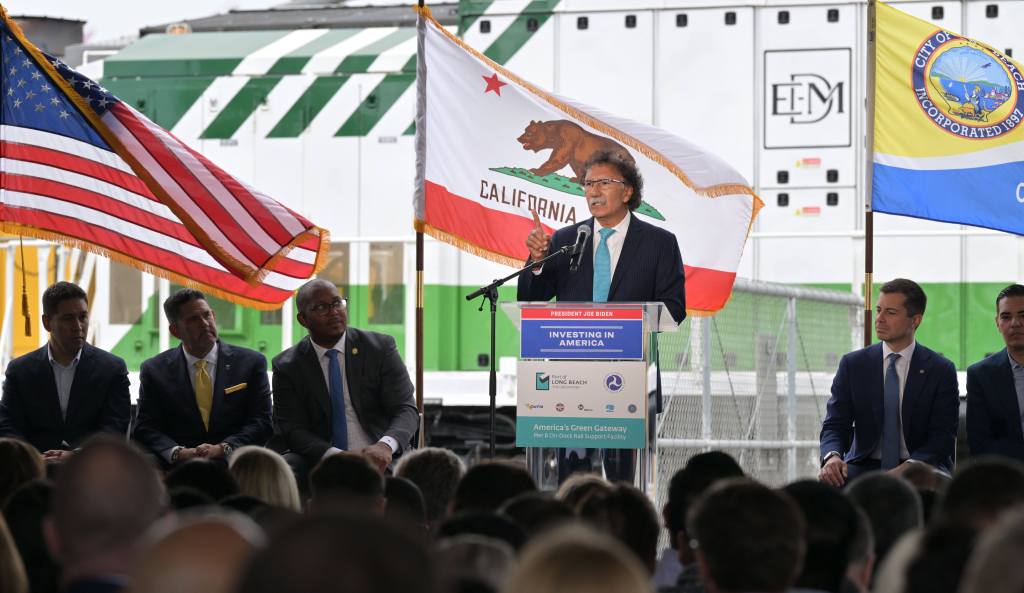Annual updates on how the ports of Los Angeles and Long Beach are meeting their emissions goals are being presented this week, with the latter issuing its report on Monday, Oct. 13 — saying it had outperformed goals that were set for air quality.
The Port of L.A. will present its most recent findings during the Thursday, Oct. 16, harbor commission meeting; officials said they could not publicly comment on the findings until the report is presented to the harbor commission.
While both ports, however, still have much work ahead to reach zero-emissions goals set out in a joint Clean Air Action Plan adopted in 2005, they have shown progress through the years.
“When the Port of Long Beach started this sustainability journey two decades ago,” Port of Long Beach CEO Mario Cordero said in a statement, “we were told it would negatively affect our commercial growth. Instead, we are moving record volumes of cargo more cleanly than ever. Though our ultimate goal is a zero-carbon supply chain, we can all be proud of where we are today.”
POLB’s 2024 comprehensive annual emissions inventory, available at polb.com/emissions, was presented at the Long Beach harbor commission meeting on Monday. It reported that since 2005, the baseline year emissions are measured against, diesel particulates declined by 90%, nitrogen oxides by 68% and sulfur oxides by 98%.
Those improvements took place as cargo increased 44% from 2005 to 2024, according to the port’s update.
Goals set in the port’s 2010 Clean Air Action Plan for 2023 called for reductions of 77% for diesel particulates, 59% for nitrogen oxides and 93% for sulfur oxides.
Some categories of emissions increased in the short term from 2023 to 2024. Year-over-year, diesel soot and nitrogen oxides rose by 23% and 12%, respectively. Sulfur oxides decreased 2%.
The primary factor impacting emissions during that time, according to the port, was a record 9.6 million twenty-foot equivalent units of container cargo handled in 2024, 20.3% more than the prior year. The port also included dredging boats in the inventory for the first time, which increased harbor craft emissions but provides additional transparency and accountability for port-related sources.
Greenhouse gases also are up by 16% since 2017.
Over the next decade, port plans call for investing $222 million to support zero emissions and energy resiliency, including projects for the port’s own fleet of equipment and vehicles. On top of that, individual terminal operators and other stakeholders are contributing to the effort.
All six container terminals at the Port of Long Beach have projects to support zero-emissions cargo-handling equipment, which currently comprise 21% of the fleet. The port’s zero-emissions infrastructure plan also includes, but is not limited to, hydrogen fueling facilities for fuel cell-powered cargo-handling equipment, shore power for non-container terminals and transitioning the port’s harbor craft fleet to zero emissions.
Along with the Port of Los Angeles, Long Beach this fall has pledged further commitments to the plan and overall goals, according to a Port of Long Beach statement. Labeled “CAAP Plus” measures, they include extensive infrastructure planning to support zero-emissions technology and enhancing incentives for cleaner ocean-going vessels, the largest source of emissions at the ports, through strategies and incentives.
The measures also call for accelerating shore power, collaborating with the South Coast Air Quality Management District to prioritize spending Clean Truck Fund Rate revenue to subsidize the transition to zero-emissions trucks and infrastructure, and developing a zero-emissions drayage truck utilization incentive program.
“Good jobs and economic development don’t have to come at the cost of environmental sustainability,” Long Beach harbor commission President Frank Colonna said in a written statement. “The results prove that last year, we had historic volumes while at the same time moving these containers more efficiently than ever. There is more to accomplish, but at this moment we would like to thank our tenants, harbor workforce and industry partners because our air quality gains wouldn’t be possible without their collaboration.”
Both ports have also reached green shipping corridor agreements with Shanghai and Singapore – two of the busiest seaports in the world – to support the transition to low- and zero-emissions fuels by ships to decarbonize the maritime supply chain. They have also enlisted the participation of port authorities, ocean carriers, governments, fuel suppliers and climate activists to reach that goal.

